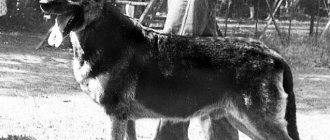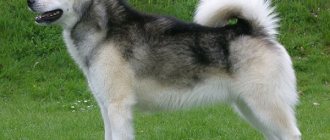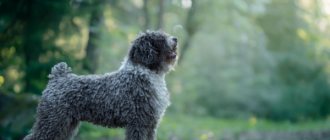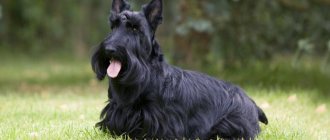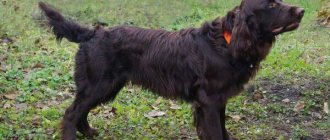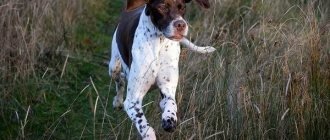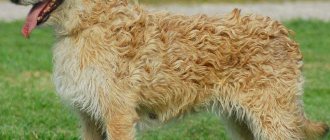| Intelligence: |
| Aggressiveness: |
| For security: |
| For children: |
| Training: |
| Difficulty in care: |
The oldest dog breed on the Iberian Peninsula is the Estrela Shepherd Dog, also known as the Cao da Serra da Estrela and the Portuguese Cattle Dog. This is the most popular breed in Portugal, but little known outside its borders.
The homeland of the Estrela Shepherd Dog is considered to be the territory of the modern reserve “ Serra da Estrela ” in Portugal. Most likely, the ancestors of the Portuguese Cattle Dog were Asiatic Dogs and Roman Molossians. The selection of the breed took place in almost complete isolation due to the mountainous terrain, so owners could select dogs with the desired characteristics. The resulting dogs were able to become excellent shepherds who protected the herd from wild animals, the dogs were very brave and hardy, and could go without food for a long time. Very often these dogs were also used as sled dogs.
Since the 16th century, Estrelians have entered the homes of the nobility, where they become wonderful companion dogs. Almost until the beginning of the 20th century, this breed was unknown to the world canine community, due to the inaccessibility of their area of residence. The situation did not change significantly after the adoption of the breed standard in 1934, and only in the 70s. These dogs began to gain rapid popularity.
Origin story
It is believed that this is a historically established breed that existed on the territory of modern Portugal during the times of Ancient Rome, it was capable of performing many functions that were necessary for humans. Then people fed from the herd and did not have the opportunity to reliably fortify their estates from robbers and wild animals. This is where the Estrela Shepherd dog, also called:
- Estrela mountain dog;
- Portuguese Shepherd;
- cao da serra da estrela.
There is an opinion that it has roots associated with the Spanish Mastiff, but there is no official confirmation.
For a long time, the breed was not in great demand in mountainous areas, in pastures and in other similar areas; the Portuguese preferred foreign dogs. This happened until dogs began to regularly win competitions at the beginning of the 20th century. The Estrela Shepherd Dog was then recognized and had a standard in 1934, and professional breeding began only in the mid-twentieth century. Pets had unique physical abilities, formed over centuries as a result of survival in the wild.
Historical reference
The breed is well known and popular in its homeland and is almost unknown in the wider world. The Portuguese Mountain Shepherd is a dog of ancient origin, whose history is shrouded in myths and folk versions. It is known that the bone structure of the Estrela Shepherd Dog is very similar to the ancient herding and guard dogs of Portugal. The exact age of the group is unknown. Dogs most likely came to Portugal during the dawn of Ancient Rome. As you know, Molossians served in the Roman army. There is no written or other factual confirmation of this version, but this particular story seems logical.
The Estrela Shepherd is naturally formed, which gives the breed endurance. The breed was bred to suit the needs of the local population, climate, landscape, pace of life, etc. The uniformity of the livestock is ensured by the fact that there were simply no more hardy and hard-working dogs on the territory.
Note! Mistrust and determination towards strangers was not only maintained in the breed lines, but was also encouraged in the process of raising dogs.
Pedigree breeding of Portuguese Mountain Shepherds was so conserved that even in the 20th century the existence of the breed (outside Portugal) was known only by hearsay. The indigenous population of Portugal valued endurance and dedication to work, but exhibitions and shows were considered a whim and the lot of “refined foreign breeds.”
The first shepherd dog was shown in the big world only in 1908. Several fans of the breed brought their favorites to see their working qualities. The Estrela Shepherd Dog was shown working with herds of cattle and what was seen greatly impressed both the judges and the audience.
Over the next 10 years, Portuguese Mountain Dogs became regular competitors. It’s interesting that the conditions for victory became more and more tough, but the four-legged animals completed the tasks with ease every time.
In 1922, a black version of the breed standard was developed in Portugal, which was approved after complete stabilization of the exterior. In the first version of the standard, very important breed characteristics were missed, which set pedigree breeding back several steps. Thanks to enthusiasts who spared no effort, no money, no time on educational work, a more complete standard was created.
Since the 1950s, professionals have taken up the breeding of Estrela Shepherd Dogs, who were concerned not only with the practical side of the issue, but also with the uniformity of the livestock. Representatives of the breed group began to appear frequently at shows, and since the appearance of the dogs is truly impressive, this fueled the interest of experts and the public.
This is interesting! At the peak of their popularity, all Portuguese Mountain Shepherds found their niches, the long-haired four-legged dogs shone at show shows, and the short-haired dogs became the cherished dream of farmers.
Description of the breed
This pet is somewhat different from the usual version of the dog, since its body is slightly longer than usual.
| Appearance | Characteristics |
| Head | Somewhat prominent, wide, with a convex skull. But the muzzle has an elongated shape, which tapers closer to the tip of the nose. |
| Ears | Long, triangular, hanging. |
| Eyes | Not a remarkable shape, but amber in color. |
| Nose | Usually available in the same color as the base coat, but ideally it is jet black. |
| Tail | Not short, but not too long, has a crescent shape. In a relaxed state it hangs freely, and when tense or running it becomes higher than the body. |
| Eyes | Not a remarkable shape, but amber in color. |
| Wool | Medium length, characterized by rigidity, sometimes the coat is smooth. |
| Color | Usually wolf or with brown tints, but also fawn, brindle, and grayish-yellow. If another option or combination is observed, then the breed cannot be called pure. |
In general, such a shepherd, if you give it a psychological portrait, is relatively calm and active. She has no outbursts of anger towards those whom she recognizes as her own. Only she still has character, she strives to be a leader. Therefore, when a new owner takes a puppy or an adult, he must show her who is the leader among them.
Appearance
The Estrela Shepherd Dog is a large, but at the same time harmonious, proportionally built dog. The body is of a moderately elongated format. Sexual dimorphism is well expressed.
- Height at the withers of males - 65-73 cm; weight - 45-60 kg;
- Height at withers of females - 62-60 cm; weight - 35-45 kg.
The head is of good size, strong and long. The skull is well developed. The stop is weakly expressed. The muzzle is long, tapering towards the lobe, not pointed. The bridge of the nose has a slight hump. The lobe is preferably black. The lips are well defined, large, but not too thick or overhanging. The mucous membrane of the palate and the edges of the lips are darkly pigmented. Scissor bite. The eyes are oval, small, set straight, well open. The eyelids are tight fitting and black. The ears are relatively small, thin, triangular, drooping, and fall back to the sides of the head. The neck is straight, thick, short, the dewlap is weakly defined.
The body is proportional, moderately stretched format. The back is short, almost flat. The loin is wide and short. The croup is sloping. The chest is round, wide, its depth is less than 1/2 the height at the withers. The hemline is slightly tucked. The tail is of natural length, thick, saber-shaped, and is crocheted at the end. During movement and excitement, the dog raises it above the line of the back, but even in this position it does not touch the croup. The limbs in a quiet stance are straight, vertical, with strong bones, developed muscles and moderately pronounced angles. The paws are proportional, not too rounded, but not long either. The toes are arched, and the fur forms thick brushes between the pads. The claws are black and strong.
The coat is thick, dense, not too hard. The texture is reminiscent of goat hair. The undercoat is dense, short, lighter than the outer coat. At the roots it is intertwined with the spine. Depending on the length of the coat, there are two types of Estrela Shepherd Dogs:
- Long-haired - the coat is straight or slightly wavy. On different parts of the body of different lengths. On the head, metatarsals, and forearms it is shorter and thicker. On the ears, even shorter, thin and soft. The tail is fluffy, with a tassel at the end. There is a mane around the neck and throat. There are fringes on the back of the forearms and thighs. On the back, the hair splits, forming a parting.
- Shorthair - short hair evenly covers the dog's body. Does not form combs. On the metatarsals, head and forearms the hair is slightly shorter.
Colors:
- Plain (wolf, fawn, gray, yellow);
- Brindle (fawn, gray, yellow with dark brindle);
Any color is characterized by a dark mask on the head. Minor white markings on the throat, chest, and paws are allowed.
Pros and cons of the breed
- Attentive and persistent security guard
- A true loyal friend
- A great companion
- Able to accompany children
- Easily survives almost any weather, as it is designed to live outdoors
- Gets along easily with other animals she is used to
- Smart and adaptable, she has no difficulty learning new things
- Rarely gets sick, requires minimal care
- In some cases, there is an overly aggressive attitude towards strangers
- It can be difficult to find for purchase or breeding, rare
- Can't live in an apartment
Breed Features
The Estrela Shepherd Dog is particularly distrustful of strangers; sometimes it is overly aggressive with those it does not know. But a properly raised dog will not make unnecessary movements if it is properly trained and tamed. These qualities are capable of saving the life and property of the owners, and for them this breed is a real find, because the loyalty of such a pet is limitless.
This dog will not live indoors, it is extremely vigilant and will not let anyone in from outside the area it considers its home. In such conditions, she feels freedom, satisfaction and a sense of control over what is happening, which is required of a true leader.
Nutrition
Not all large dogs eat really a lot, this also applies to the Estrela Shepherd, who prefers regular meals to support the body under serious stress. After all, her physique is rather sinewy, strong, with a minimal proportion of body fat. Therefore, the dog eats twice a day in medium portions, which must include:
- About half protein.
- Zlakov.
- Complex of vitamins and minerals.
Usually, in order not to make a mistake, the owners buy professional food for their animal and give it once a day, the rest is at their own discretion.
Maintenance and care
Most of the conditions and requirements for keeping an Estrela Shepherd Dog relate to the living conditions and skills of the owner. In terms of care, these dogs are absolutely unpretentious. The dense, double coat requires brushing and combing during the shedding period. A long-haired dog is combed 2 times a week, a short-haired dog is brushed with a soft brush once a week. Swimming no more than 2 times a year.
The eyes are rubbed and examined daily. Ears are cleaned as a preventive measure, but not often. Nails are trimmed as needed. Feeding should be balanced. Despite their size, Portuguese Mountain Dogs do not eat much. An adult quadruped adapts well to feeding once a day, although feeding twice a day is more acceptable to maintain metabolism.
Health
Although this breed is considered particularly strong and hardy, it has vulnerabilities that should be taken into account when caring for the dog’s health. He is constantly on the street, where many unsafe surprises await him, so you need to vaccinate your pet according to the veterinarian’s recommendations. And also such a dog has a predisposition to certain diseases at the genetic level, this applies to:
- Hip dysplasia.
- Skin diseases, especially after frosts when the integument freezes, after heat, when the dermis under the fur gets warm. Sometimes due to stress there can be rashes.
- Cardiomyopathies.
- Volvulus (features of the gastrointestinal tract).
Most of these potential problems can be solved through a competent approach to caring for your pet.
Breeding
With the breeding of representatives of the Estrela Shepherd Dog breed, there are questions directly related to the non-prevalence of pure representatives. Before agreeing on a litter, you need to make sure that the dog on the other side meets the standard. But this can rarely be found outside the Portuguese border, so if questions arise about the availability of a photo, you should be especially careful.
To find reliable representatives of the breed, it is recommended to contact those who breed these pets in Portugal. It is there that the concentration is greater than in any other country, and the purity of the breed is more likely.
Character and training
Estrela Shepherd puppies look like harmless and very cute bear cubs. As the dog grows up, it begins to show a character that is just developing, that is, it does not seem like a serious problem to an inexperienced owner. When the dog becomes an adult, or at least physically functional, the problems become obvious, but correcting them requires the help of a professional.
So, the Portuguese Mountain Shepherd is a bad choice for a beginner who is unfamiliar with the habits of service dogs that are prone to making independent decisions. This is a bad choice if the dog is purchased for a sofa or occasional walks. This is a bad choice for an apartment and people who are not confident in their financial situation.
For centuries, Portuguese Mountain Shepherds protected homes and herds from wolves, which is why modern representatives of the breed are very confident . The four-legged animal reacts without hesitation to any potential danger, behaves fearlessly and is not always ready to obey. If a pet is deprived of work, it needs exercise. By the way, in the USA this breed is called a sports breed, since the stamina of shepherd dogs can be envied.
Note! It is normal for the Portuguese Mountain Shepherd to be distrustful and wary of strangers.
As a small puppy, the four-legged dog begins to protect the home and all family members. Active socialization will help you avoid problems and excessive aggression towards strangers. It is especially important to introduce the ward to other dogs and their owners.
Note! Portuguese Mountain Shepherds are very territorial, but with the right approach, they get along well with other dogs and cats.
At a young age, all shepherd dogs of this type experience teenage rebellion. The dog tries to take a dominant place in the family, and it is at this stage that it becomes clear how the family will live in the next 5–7 years. The owner has a choice:
- Actively engage with the dog, calmly but firmly show who is the leader of the pack.
- Accept the rebellion and wait for trouble, because when the four-legged one establishes itself in the rank of leader, everyone will have to live by his rules.
- Limit the dog's capabilities by putting him on a chain or closing the enclosure, which will lead to mental disorder, uncontrolled aggression or panicky cowardice.
Main diseases and problems
Diseases of this type of dog mainly depend on the quality of care and the individual degree of susceptibility to specific diseases. Typically, the health of this species does not involve difficulties in maintaining and frequent problems, because from time immemorial it has been running and frolicking in the open air. Although an incorrectly bred breed may pose dangers such as an unforeseen imbalance in vulnerability to disease.
You just need to periodically check your pet for ailments such as:
- Clogged ears.
- Eye discharge or inflammation.
- Dysplasia of the hip joint.
- Digestive problems, abdominal pain that can lead to volvulus.
- Fatigue too quickly, decreased activity, which can indicate heart problems.
Dogs can fall in love
When a dog comes into contact with people or other dogs, oxytocin, the love hormone, is released in its brain, this process is identical to what happens in the human brain when hugging or kissing.
A dog is the first animal to orbit the Earth
Laika became the first living creature to orbit the Earth. Her flight on Sputnik 2 took place in 1957. Although she herself died during the flight, her daughter, Pushinka, gave birth to 4 puppies from the terrier Charlie, whose owner was US President John F. Kennedy.
Collies were once considered a vicious breed
Collie was once considered a vicious breed of dog, mainly due to the fact that this breed is of Scottish origin, and the Scots were considered uneducated and poor people. Collies became a popular and prestigious breed in the 19th century when Queen Victoria became a fan.
Appearance
This dog breed has the following appearance:
- Average height (about 45–55 centimeters).
- Weight varies from 17 to 27 kilograms.
- With shaggy, long and straight (sometimes slightly wavy) coat.
- Due to its color (most often white-black, brown-black, brown-white, gray-black or gray-brown), the Portuguese Shepherd appears to have a mustache and beard on its face.
- The body has a slightly elongated shape.
- The head of Portuguese Shepherds is wide and large.
- A characteristic difference is the slightly upturned nose, on which the nostrils stand out well.
The forehead is clearly defined, rectangular. Portuguese Shepherds have round eyes with black rims. The ears are not very large, hanging. The chest is wide and strong.
Since these dogs love activity, their paws are strong, with well-developed muscles. The pads of the fingers are thick to make running easier. The tail is small, droops down, but in moments of emotional activity (from joy, during games) it is raised up. The age range of life ranges on average from 12 to 17 years.
